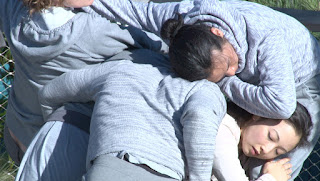Event 3
For my third event, I attended the Leonardo Art Science Evening Rendezvous which took place at CNSI presentation room on May 25, 2017. It is Leonardo/ISAST's international program of evening gatherings that bring artists and scientists together for informal presentations and conversations. The LASER speakers are Claudia Schnugg, Tamira Elul, Stefanie Volland, Behnaz Farahi, Hans Barnard, Symrin Chawla, and David Ertel. Their recent work focuses on intertwining artists and art projects with new technologies and scientific research.

I was impressed by the work done by Dr. Claudia Schnugg. She was affiliated with the Sparks project, an H2020 project focusing on making Responsible Research and Innovation (RRI) accessible and comprehensible for general public. A device named "Agent Unicorn" was created in this project. It is a unicorn horn shaped headpiece which includes a camera and it is based on electroencephalography (EEG). There are electrons within the headpiece. Whenever your attention is attracted, the camera on the headpiece records what is happening in front of you. The device is used in a research for children who have ADHD (attention deficit hyperactivity disorder). The research is to find out how children can get a sense of what is attracting their attention by having the camera recorded it. The device sends the data to the web interface, which allows them to analyze it later. This reminds me of the two cultures lecture we had at the beginning of this quarter. It is difficult to identify it is an art project or science project. It is more like art, neuroscience, robotics, computer science and mathematics all comes together. The subject cannot be done without any of these aspects.

"Agent Unicorn" is used to research children who have ADHD
What is ADHD?
Another project that impressed me was done by Behnaz Farahi. She created a device called Synapse which is a multi-material 3D-printed wearable piece that moves and changes shape in response to the activities of the brain. The main intention of this project is to explore the possibilities of multi-material 3D printing in order to produce a shape-changing artwork around the body as the second skin. The project is also intended to explore direct control of the movement with neural commands from the brain so that we are able to effectively control the environment around us through our thought. Again, similar to Dr. Claudia Schnugg’s work, Behnaz’s project shows how contemporary art and science are important to each other. The third culture is presented almost everywhere in today’s life. As an engineering student, I truly realized how art is important to my future career field.
Synapse by Behnaz Farahi
I would definitely recommend this event to other students. The event truly refreshed my mind and provided me with huge amount of information that I did not know. In week 9, our discussion is based on space and art. I agree with the idea that Week 9's materials sum up all previous topics. However, the information gathered from the event is much more than that. For example, during the event, Hans Barnard also mentioned how archaeology is important to contemporary art, which I did not discuss in details above.
References
"Art & Science Collaboration – Creating Fertile Ground." Claudia Schnugg. N.p., n.d. Web. 04 June 2017. www.claudiaschnugg.com/projects/.
Behnaz Farahi. " Synapse" Vimeo, 2015, vimeo.com/139237974.
Jeff Schmidt. " What is ADHD?" YouTube, uploaded by Smarter Parenting, 14 April 2016, www.youtube.com/watch?v=Q8MyDqb5_Ok.



Comments
Post a Comment